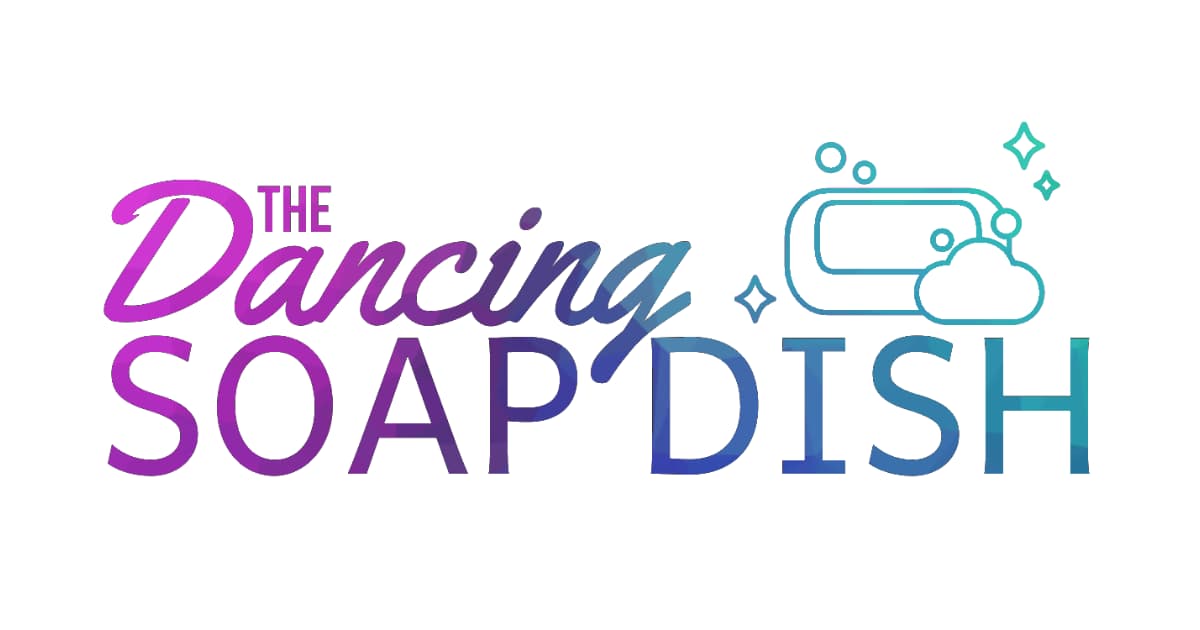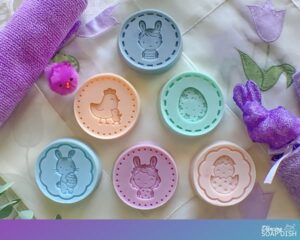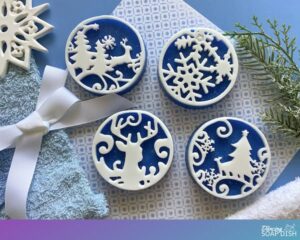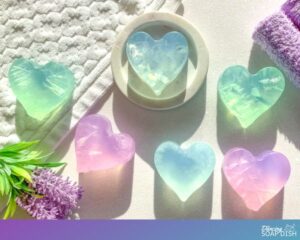Complement your bathroom décor with these impressive glass tile effect melt and pour soap bars.
You can match your existing tile, or perhaps that gorgeous glass tile you’ve always dreamed of.
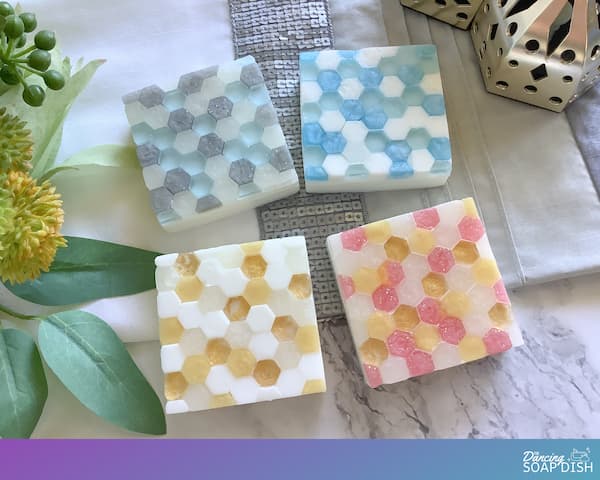
This post contains affiliate links. If you buy something through one of those links, I will receive a small commission at no extra cost to you. As an Amazon Associate I earn from qualifying purchases.
Thank you for supporting my site!
Table of Contents
My Inspiration for Glass Tile Effect Melt and Pour Soap Bars
What You Need to Make Glass Tile Effect Melt and Pour Soap Bars
Glass Tile Effect Melt and Pour Soap Bars Video Tutorial
Glass Tile Effect Melt and Pour Soap Bars Instructions and Printable Tutorial
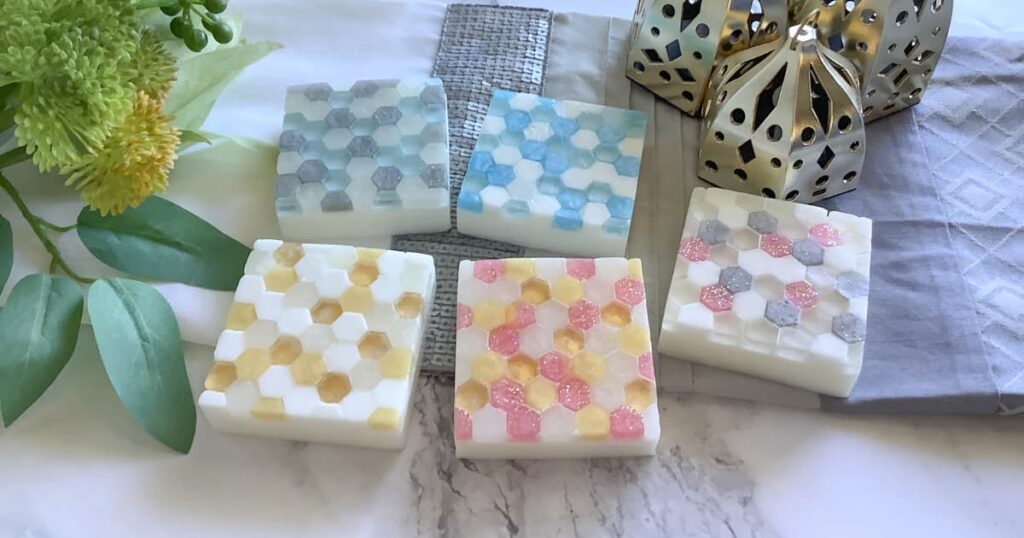
My Inspiration for Glass Tile Effect Melt and Pour Soap Bars
Last Christmas I made these mosaic soap bars which included a hexagonal tile pattern in random Christmas colours.
They reminded me of a number of exquisite glass tile designs I’ve seen on Pinterest.
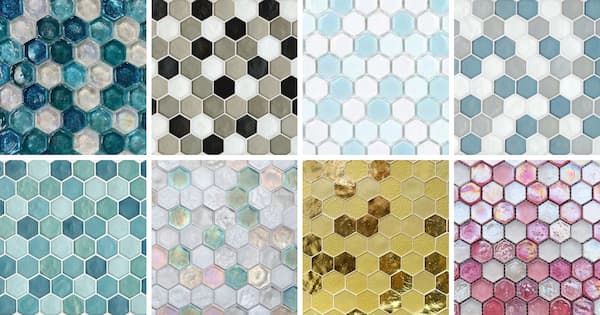
I want to try and mimic these designs using soap and I decided that glass tile effect melt and pour soap bars would be the perfect February project for my 2023 Mosaic Soap Challenge.
Again, I’m using this mosaic tile mould to make mosaic soap tiles. I’m using the hexagonal tiles only (for simplicity’s sake) which I will arrange inside these square soap mould cavities.
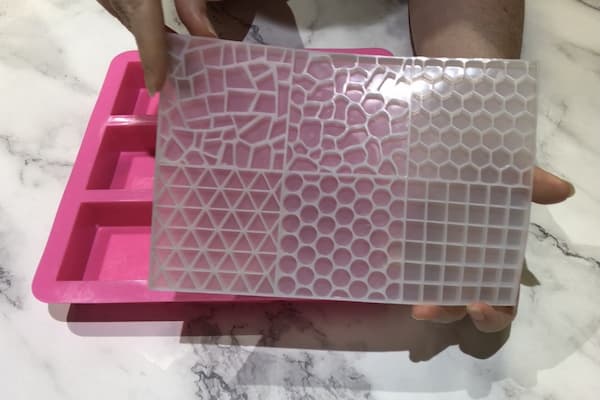
There are no gaps to fill with soap ‘grout’ this time. All of the mosaic tiles are sitting flush against each other and the bottom of the square mould.
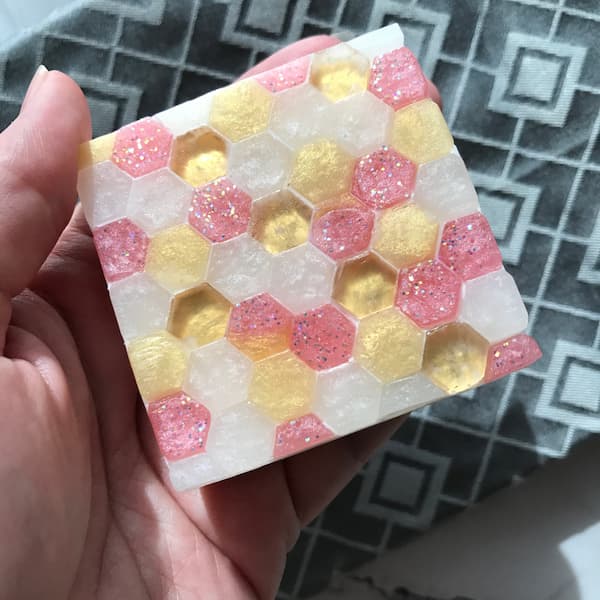
What You Need to Make Glass Tile Effect Melt and Pour Soap Bars
Melt and Pour Soap Base
Melt and pour soap is sold as large blocks that you can cut up and then weigh out the amount of soap you need.
I used mostly clear melt and pour soap base to make my mosaic soap tiles, plus a little white soap base I had left over from another batch.
The remainder of each soap bar was poured from white melt and pour soap base.
Each of my bars weighs approximately 70g (~2.5oz).
Some of the mosaic tiles were poured from clear melt and pour soap base, and some of them were made with a combination of clear and white soap base, as I wanted my mosaic tiles to have a vibrant colour but also be opaque (like the red Santa belt soap tiles).
I used a special ‘no sweat’ formula to avoid glycerine dew beading on the outside of the soap bars.
Don’t forget to add 5-10g for wastage.
Soap Moulds
To make mosaic melt and pour soap bars you need two moulds, one for the tiles and one for the remaining bar of soap.
This mosaic tile mould makes six different patterns of mosaic tiles. For this project, I used the hexagon-shaped tiles.
Live outside of the United States? You can also buy this mosaic tile mould from AliExpress.
I used this square cavity soap mould for my soap bars because each cavity measures 6cm by 6cm, which is a perfect fit for my mosaic tile designs (this discovery was a happy accident!).
You can buy square cavity soap moulds from AliExpress too.
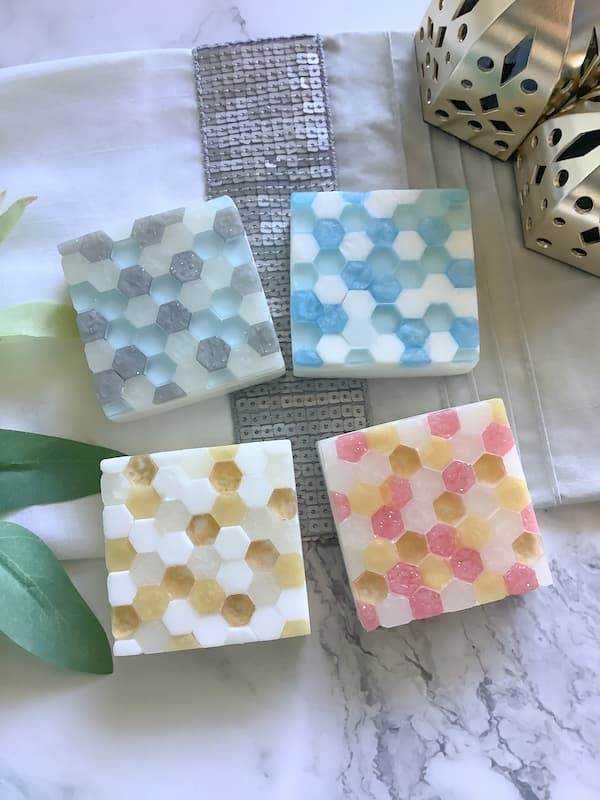
Plastic or Rubber Scraper
You will find filling the mosaic tile silicone mould much easier if you have a rubber scraper on hand to distribute the melted soap base evenly across the mould.
Live outside of the United States? You can also buy rubber scrapers from AliExpress.
Soap Colouring
I used a combination of liquid soap colouring and coloured micas to make my mosaic soap tiles.
I also used eco glitter to give my some of my hexagonal mosaic soap tiles a little bling.
I mixed and matched colourings in order to produce a range of mosaic tiles with varying degrees of opacity and shimmer.
Gold Leaf (Optional)
I gilded the back of some of my transparent soap tiles with gold leaf because I wanted my glass tile effect soaps to look extra luxurious.
However, this is totally optional. If you don’t have gold leaf you can just leave the tiles transparent.
If you do choose to use gold leaf, it must be food grade (edible) gold leaf as the moisture in the soap will cause faux gold leaf (commonly found in craft stores) to tarnish.
Essential Oils or Fragrance Oils
Scenting your soap is optional, but most of us prefer a pretty smelling soap bar.
I scented my glass tile effect soap bars with doTERRA’s AromaTouch essential oil, but you can feel free to use your favourite combination of essential oils or your preferred fragrance oil.
If you are looking for ideas, check out my list of perfect essential oil soap scents.
Small Glass Measuring Cup
I highly recommend using a small glass measuring cup to pour the mosaic tiles. An espresso measuring cup (used by baristas) is ideal as it has a double spout, a wooden handle, and can withstand high heat.
Live outside of the United States? You can also buy espresso measuring cups from AliExpress.
Alcohol in a Small Spray Bottle
Alcohol (rubbing alcohol/isopropyl alcohol or vodka) has a number of uses when making melt and pour soap:
- Spraying the soap with alcohol once it’s poured will remove any bubbles sitting on the soap’s surface.
- Spraying alcohol between soap layers helps them adhere together.
- Spraying the soap mould with alcohol before pouring the soap helps the soap spread evenly across the bottom of the mould.
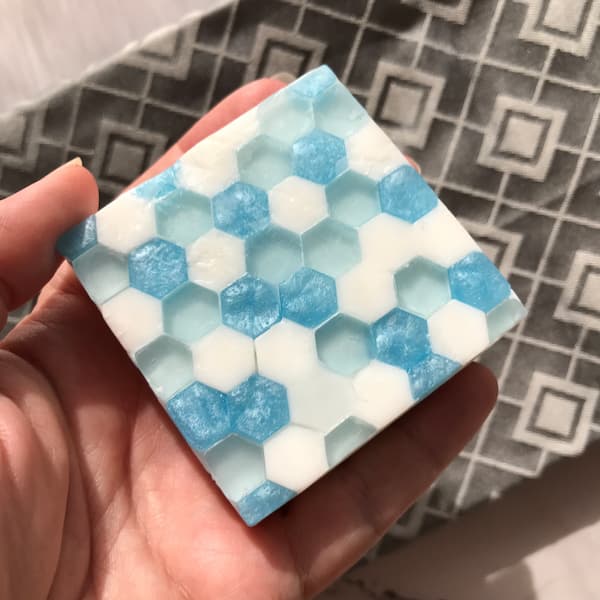
Additional Materials Required
Kitchen Scales – I’ve used grams in this recipe because the amounts are easier to manage compared with ounces. Most kitchen scales these days are interchangeable between grams and ounces. Check your scale’s instruction booklet for how to change your scale to measure in grams and then change it back when finished.
Glass Measuring Jug – You will need a larger (500ml/16oz) measuring jug to melt the white melt and pour soap base. I have a separate glass measuring jug dedicated to creative projects (soap making, lotion bars, lip balm etc) to avoid any cross-contamination of non-ingestible ingredients with food. I recommend you do the same.
Metal or Bamboo Skewer – Skewers are super handy for positioning the mosaic tiles. They can also be used for stirring the melted soap base and can be easily cleaned or disposed of.
A Tray Lined with Greaseproof Baking Paper – Position the mosaic tile mould on a piece of greaseproof baking paper on a tray before pouring to allow for easy cleaning up (there will be drips) and transport while the soap is setting.
A Breadboard and a Sharp Knife – For trimming and cutting mosaic soap tiles. An additional breadboard or tray is also handy for resting your square soap mould on a set of kitchen scales when it is time to weigh out how much soap is being poured into each cavity.
Plastic Tweezers – A pair of plastic tweezers are recommended to help coat the soap mosaic tiles with gold leaf.
Paintbrush – a soft paintbrush is required when working with gold leaf.
Microwave or Double Boiler – Melt your soap base in either a microwave or a double boiler.
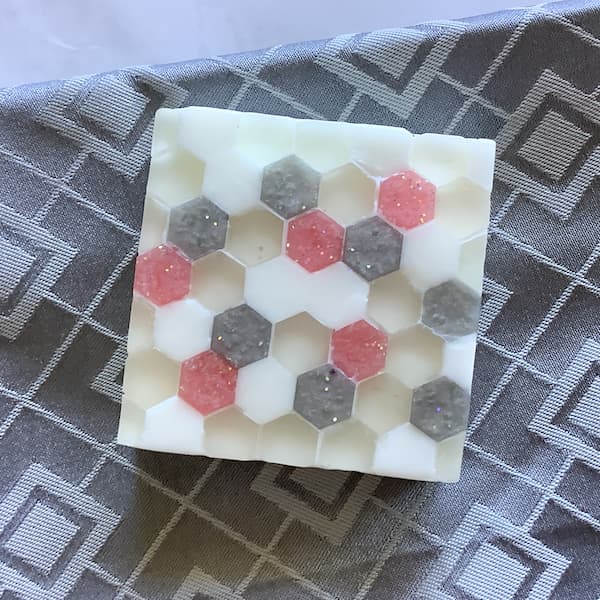
Glass Tile Effect Melt and Pour Soap Bars Video Tutorial
To make it easier for you to grasp the process, I created a video tutorial about how to make glass tile effect soap bars.
How to Make Glass Tile Effect Melt and Pour Soap Bars
Want your glass tile effect soap to look like mine?
First I made a bunch of mosaic tiles out of melt and pour soap base using a mosaic tile silicone mould:
Base Colours – Four sets (whole hexagonal tile section) of neutral coloured hexagonal tiles (white, pearlescent white, clear, clear blue).
Highlight Colours – Four sets (half of hexagonal tile section) of bold, shimmery colours (gold shimmer, blue shimmer, grey glitter and pink glitter).
I then positioned the tiles face-down in the cavities of a square soap mould in a random pattern of 3-4 complementary colours.
I also gilded the back several clear tiles with edible gold leaf and placed them into two of my designs.
I then melted 10g – 15g of white melt and pour soap base (includes extra for wastage) for each of the soap bars and poured it on top of the mosaic designs in each cavity to ‘seal’ the designs.
Once the seal was fully set, I poured an additional 40g of melted and scented white soap base into each cavity to complete each bar of soap.
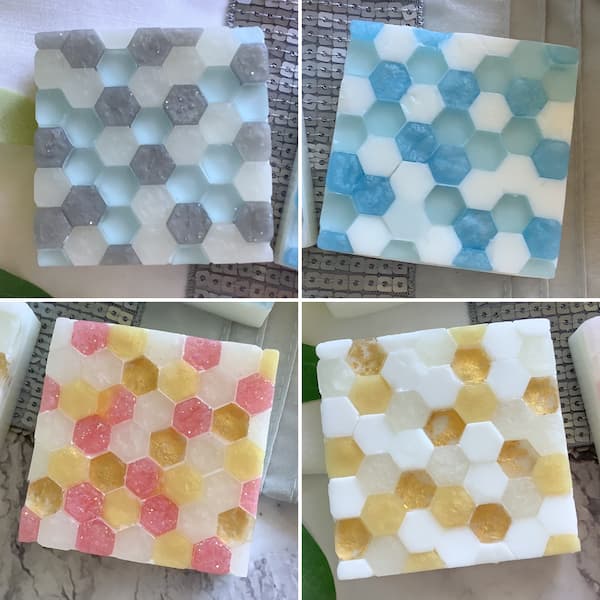
Glass Tile Effect Soap Bars Printable Tutorial

Glass Tile Effect Melt and Pour Soap Bars
Equipment
- Alcohol in a Small Spray Bottle (rubbing alcohol, isopropyl or vodka)
- Kitchen Scales
- Glass Measuring Jug
- Bamboo or Metal Skewer
- Tray lined with Grease-Proof Paper
- A Breadboard and a Sharp Knife
- Plastic Tweezers (Only required if using Gold Leaf)
- Paintbrush (Only required if using Gold Leaf)
- Microwave or Double Boiler
Ingredients
- 255 g White Melt and Pour Soap Base includes wastage
- 125 g Clear Melt and Pour Soap Base includes wastage
- Mosaic Tile Silicone Mould
- Square Soap Mould
- Rubber Scraper
- Small Glass Measuring Cup
- Soap Colouring
- Soap Fragrance or Essential Oils optional
- Holographic Eco Glitter
- Food Grade (Edible) Gold Leaf optional
Instructions
- Set out all of your equipment and ingredients ready to be used.
Mosaic Soap Tiles
- Place the mosaic tile silicone mould on a tray lined with greaseproof baking paper.
- Weigh out 25g (~0.9 oz) of melt and pour soap base and cut it up into small cubes (this amount includes wastage).
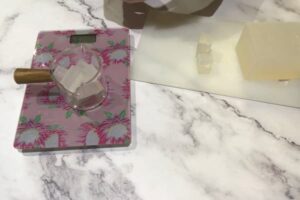
- Put the soap cubes in a small glass measuring cup with a pouring spout.
- Melt your soap base as per the instructions in a microwave or double boiler.
- Add the soap colouring (ie liquid soap colouring, coloured mica, and/or eco glitter) if using and stir well.
- Working quickly, pour the liquid soap base into the hexagon section of the mosaic tile silicone mould.
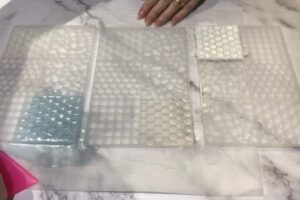
- Ensure the soap base covers the entire section of the mould by spreading it around with a rubber scraper and spraying alcohol to break the surface tension and remove any bubbles.
- Set the soap aside to set for 20-30 minutes.
- Once the soap is set, turn the mould over and push out the mosaic soap tiles onto the paper-lined tray while bending and flexing the mould.
- Clean the mould if necessary and repeat the process to make all of the following tiles:– 4 sections of neutral-coloured tiles to be used as a majority of your design, or 'base tiles'(white, clear, clear blue, pearlescent white).– 2 sections of bright-coloured/glitter tiles to be used as highlights (blue, gold, pink, grey).Highlight tiles need only be half a hexagon tile section of the mould, therefore you should be able to yield 4 different coloured highlight tiles from 2 sections of the mould.The quantities of soap base listed in this tutorial allow for 1 section to be made with white melt and pour soap base, and the remaining 5 sections to be made with clear melt and pour soap base.
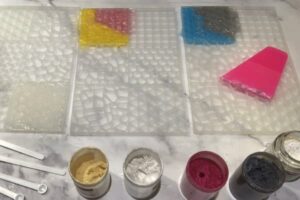
- Use a breadboard and a sharp knife to cut up and trim the mosaic soap tiles if required.
- Sort the soap tiles by shape and separate the 'part' tiles (i.e. the edge pieces) from the 'whole' tiles.
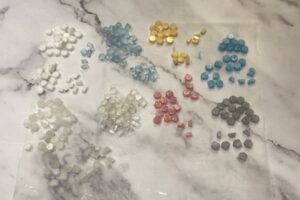
Mosaic Soap Bars
- Place the square soap mould on a tray or breadboard.
- Start assembling mosaic tile designs (face down) in four cavities of the soap mould.
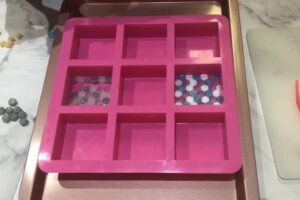
- Use a metal or bamboo skewer to carefully push all the mosaic soap tiles to exactly where you want them positioned.
- If using edible gold leaf, gild the backs of several clear soap tiles by using plastic tweezers to place the tiles face-up onto the gold leaf.
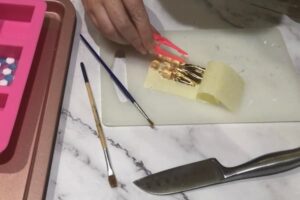
- Pick the tiles up again with the tweezers and use a paintbrush to remove any excess leaf from around the edges.
- Pat the gold leaf down onto the back of the soap tile with the paintbrush to ensure it adheres well.
- Insert the gilded tiles into your mosaic designs (with the gold leaf facing up).
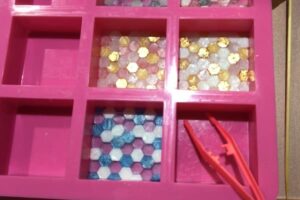
- Weigh out 60g (~2.1oz) of white melt and pour soap base and cut it up into small cubes. This includes wastage.
- Put the soap cubes in a glass measuring jug with a pouring spout.
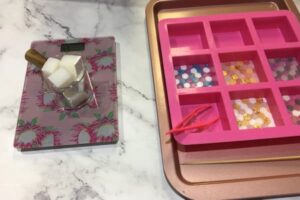
- Melt your soap base as per the instructions in a microwave or double boiler.
- Scent your soap with fragrance oils or essential oils (optional).
- Pour a small amount (10-15g) of soap into each mould cavity until the surface of the mosaic is completely covered.
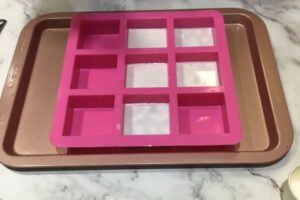
- Spray the soap with alcohol to remove any bubbles.
- Allow the thin layer of soap to set.
- Weigh out 170g (~6oz) of white melt and pour soap base and cut it up into small cubes. This includes 10g for wastage.
- Put the soap cubes in a glass measuring jug.
- Melt your soap base as per the instructions in a microwave or double boiler.
- Scent your soap with fragrance oils or essential oils (optional).
- Set the soap mould (sitting on a tray or breadboard) on top of a set of kitchen scales and press TARE.
- Spray the surface of the set soap inside each cavity with alcohol to help the soap layers adhere to each other.
- Pour 40g (1.4oz) of liquid soap base into each cavity, resetting the scales to ‘0’ between pouring each cavity.
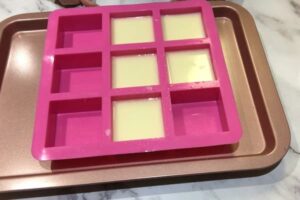
- Spray the surface of the soap with alcohol to remove any bubbles.
- Allow the soap bars to set overnight.
- Remove your gorgeous glass tile effect soap bars from the mould.
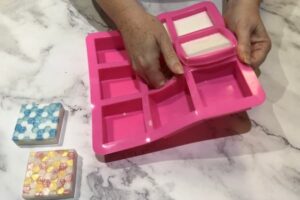
Notes
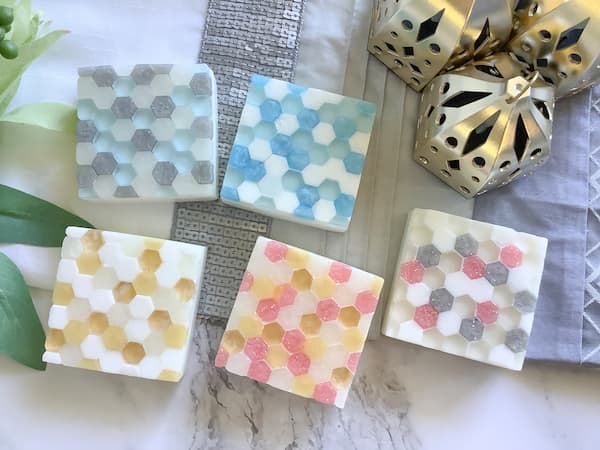
Enjoy!
